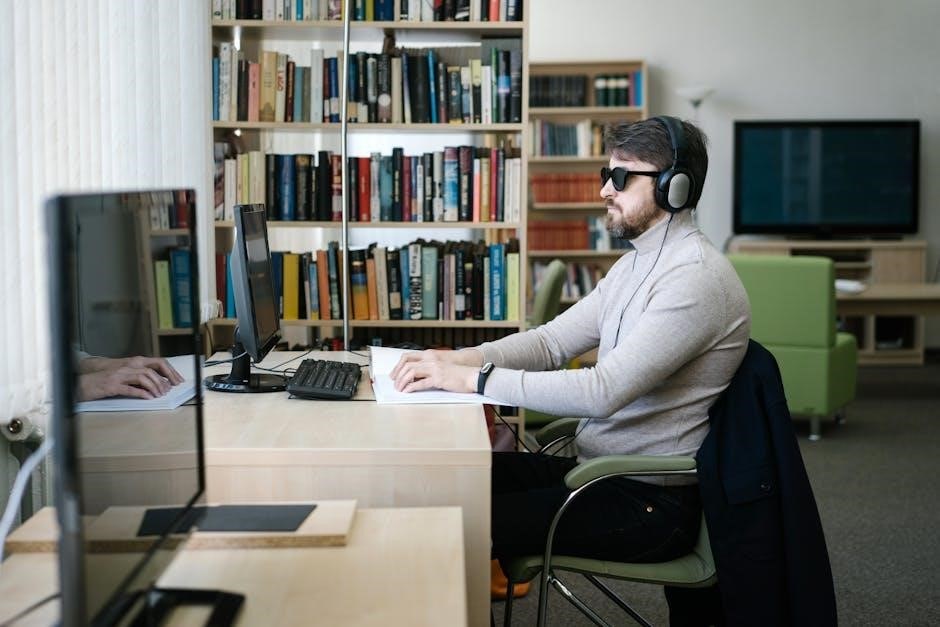Running guides assist visually impaired runners, providing support and guidance, enabling them to participate in running activities, with many organizations offering training and workshops for guides and runners alike every day.
Overview of Visual Impairment and Running
Visual impairment affects many people, with varying degrees of sight loss, and running can be a great way to stay active and healthy. Many organizations offer running guides for visually impaired people, providing them with the support and guidance they need to participate in running activities. Running guides are trained to assist visually impaired runners, helping them to navigate obstacles and stay safe while running. With the right support and guidance, visually impaired people can enjoy the many benefits of running, including improved physical health and mental wellbeing. Running can also provide a sense of freedom and independence, which is especially important for people with visual impairments. By providing running guides and accessible running programs, organizations can help to make running more inclusive and accessible for everyone. This can have a profound impact on the lives of visually impaired people, enabling them to lead more active and fulfilling lives.

Benefits of Guided Running for Visually Impaired
Guided running provides visually impaired people with independence and confidence, enabling them to exercise regularly and improve overall health and wellbeing every single day safely.
Importance of Guides in Running for Visually Impaired
The role of guides in running for visually impaired individuals is crucial as they provide assistance and support, enabling them to participate in running activities safely and effectively. Guides help visually impaired runners to navigate through different terrains and obstacles, and they also provide motivation and encouragement. With the help of guides, visually impaired runners can improve their overall health and wellbeing, and they can also gain a sense of independence and confidence. Many organizations offer training and workshops for guides, where they can learn about the different types of visual impairments and how to provide effective support. By becoming a guide, individuals can make a positive impact on the lives of visually impaired runners and help them to achieve their goals. Guides play a vital role in promoting inclusivity and accessibility in running.
Types of Visual Impairment and Running
Visually impaired runners have varying levels of visual impairment, including blindness and partial sight, affecting their running experiences and guide requirements always differently every day.
Understanding Different Types of Visual Impairments
Understanding the different types of visual impairments is crucial for running guides to provide effective support. Visual impairments can range from partial sight to complete blindness, each requiring unique guidance and communication methods. Guides must be aware of the individual’s visual capabilities to provide tailored assistance, ensuring a safe and enjoyable running experience. The internet provides valuable resources and information on the various types of visual impairments, enabling guides to better comprehend the needs of visually impaired runners. By gaining a deeper understanding of visual impairments, guides can develop the necessary skills to support runners with confidence and sensitivity, fostering a positive and inclusive running environment for all participants, regardless of their visual abilities, and helping them to reach their full potential as runners. This knowledge is essential for creating a supportive community.

Guide Running Techniques and Safety
Guides use verbal cues and physical guidance to ensure safe running techniques for visually impaired runners every day.
Top Tips for Guide Runners and Visually Impaired Runners
Guide runners and visually impaired runners can benefit from several tips to ensure a safe and enjoyable experience. Communication is key, with guides providing verbal cues and feedback to the runner. Guides should also be aware of their surroundings, including potential obstacles and hazards. Visually impaired runners can benefit from wearing identification, such as a vest, to indicate their visual impairment to other runners and pedestrians. Additionally, guides and runners should discuss and agree on a communication plan before starting a run, including how to handle emergencies and unexpected situations. By following these tips, guide runners and visually impaired runners can build trust and confidence, allowing them to focus on their running and achieve their goals. Effective communication and planning are essential for a successful and enjoyable guided run. Runners can find these tips online or through running organizations.

Workshops and Training for Guide Runners
Guide runners receive training through workshops and organizations to support visually impaired runners effectively every day online.
Supporting Visually Impaired Runners through Workshops and Training
Supporting visually impaired runners is crucial for their participation in running activities, and workshops play a significant role in this. These workshops provide guide runners with the necessary skills and knowledge to support visually impaired runners effectively. The training covers various aspects, including communication, guiding techniques, and safety protocols. By attending these workshops, guide runners can gain a better understanding of the needs of visually impaired runners and learn how to provide them with the support they need to participate in running activities. This enables visually impaired runners to participate in running events and activities with confidence, knowing that they have the support of trained guide runners. Overall, workshops and training are essential for supporting visually impaired runners and promoting their participation in running. This support is vital for their overall well-being and participation in the sport.

Paralympic Rules and Guided Running
Paralympic rules allow visually impaired runners to compete with guides, following specific regulations and protocols for fair competition always.
Guided Running in Competitive Events
Guided running in competitive events is a remarkable display of trust and teamwork between visually impaired runners and their guides. In these events, guides play a crucial role in helping runners navigate the course, avoid obstacles, and achieve their best possible performance. The guides are trained to provide verbal cues, physical guidance, and emotional support to the runners, allowing them to compete at their highest level. With the help of their guides, visually impaired runners can participate in a wide range of competitive events, from local road races to international track and field competitions. The partnership between runner and guide is essential to success in these events, requiring a deep understanding of each other’s strengths, weaknesses, and communication styles. By working together, visually impaired runners and their guides can achieve great things and inspire others with their determination and perseverance. Guided running has become an integral part of competitive events.
